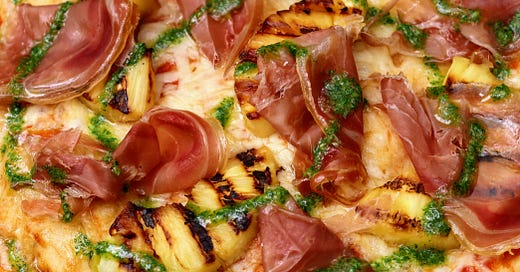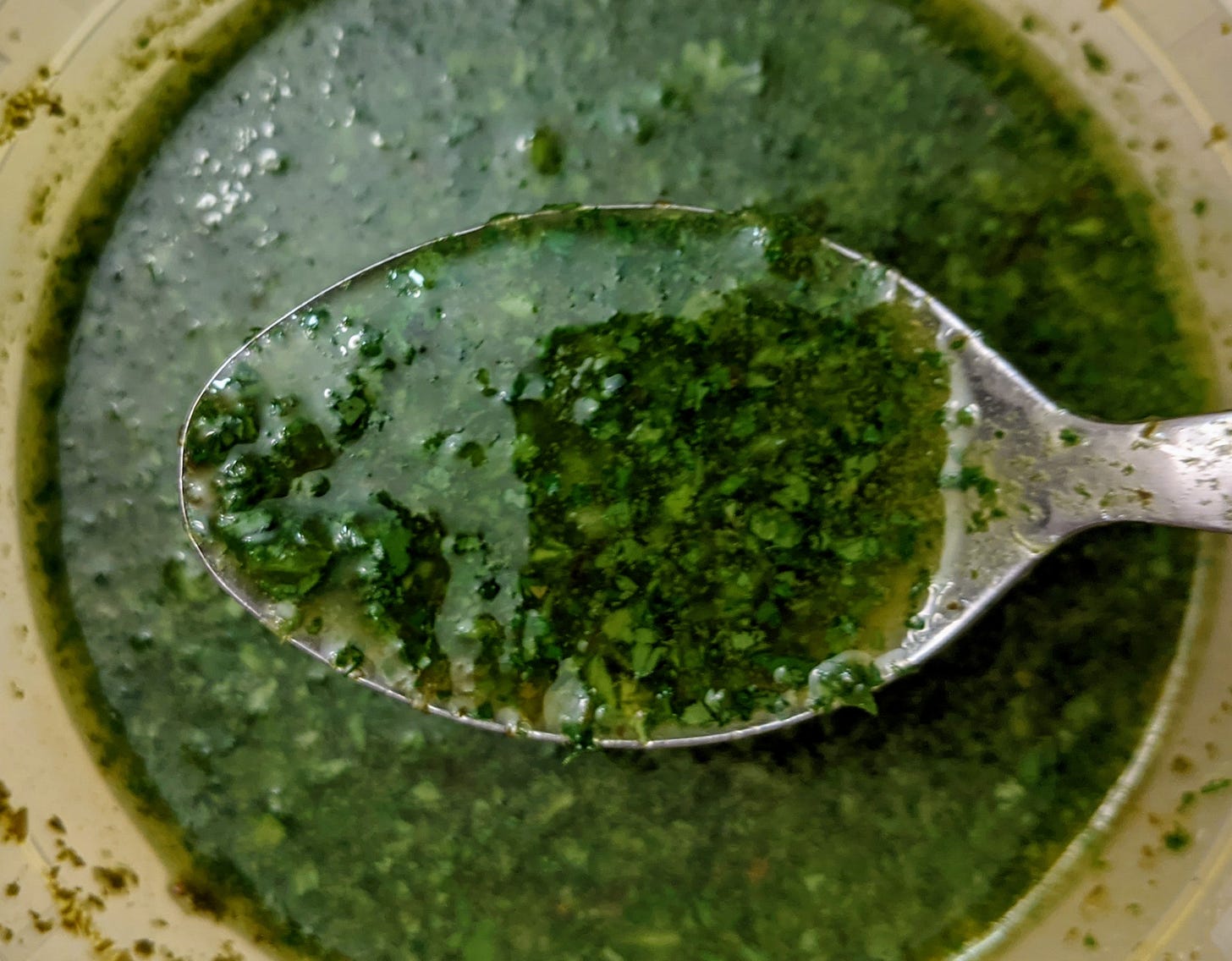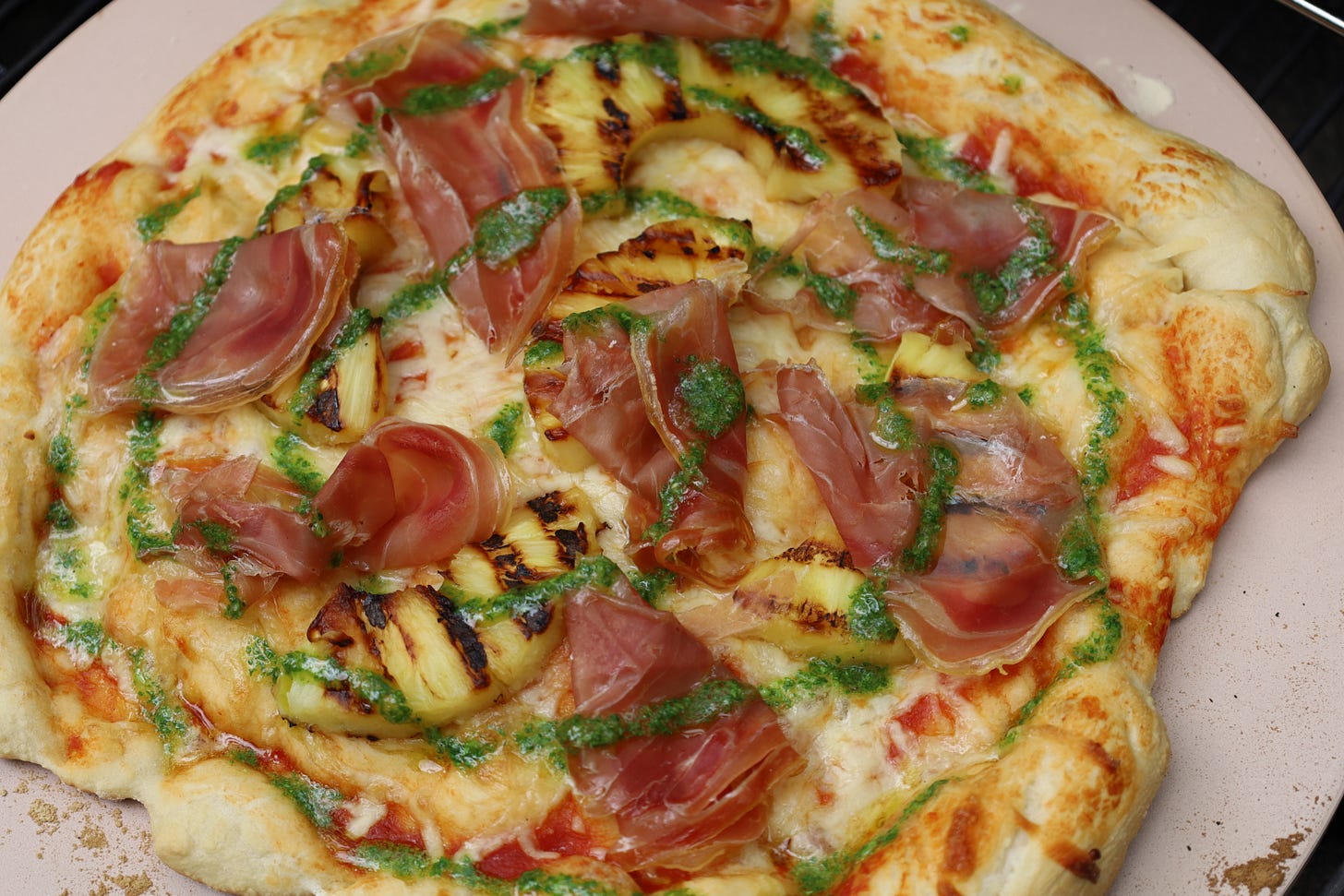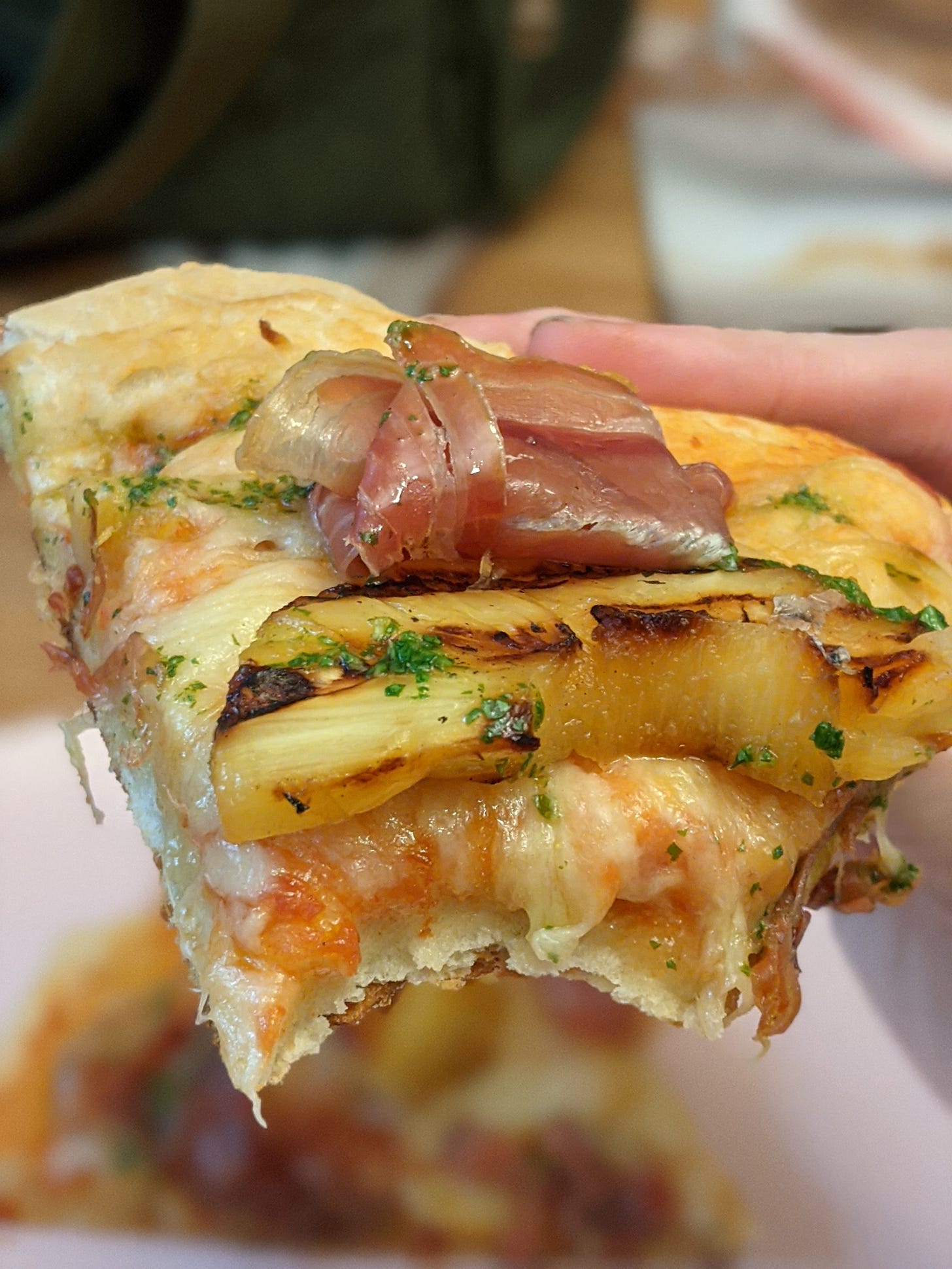Pickled Pineapple and Serrano Ham Pizza
Authenticity is a marketing tool. Pineapple on pizza is good. Especially when it's pickled and spicy.
With full acknowledgment of how dorky this makes me sound, I’m a bit of an “arguing online” connoisseur. The embers of “is a hot dog a sandwich?” or “the dress” are long burned out in my heart, and my shattered attention span spends less and less time on questions I feel are now thoroughly settled. “Does pineapple go on pizza?” is another such argument I believe should be left in the dustbin of history. The answer is an emphatic yes, because pineapple on pizza rocks.
You don’t have to eat pizza this way every time! I’m not a sweet fruit on pizza absolutist! But every now and then, such as when it’s been raining every day for a week and the temperature is rapidly dropping, but then you get one nice Saturday to be outside, the idea of a misnomered “Hawaiian pizza” strikes one as both refreshing and a fond farewell to warm afternoons outdoors. If this seems a reasonable enough idea, but you live with pineapple and ham haters, there are a few little projects you can make that will zazz up your pie enough to win them over.
One is to pickle your pineapple. Two is to use fancier ham. Three is to grill your pizza. Four is to drizzle the pie with cilantro oil. (Or some other herb if you are cursed to wander through this life with the dread soapy taste gene.) Only the first of these will require more than a few hours of forethought, and is arguably the most optional. We tackle these projects in order, but first, a note about picking your battles- I use premade dough, premade tomato sauce, and pre-shredded cheese in this recipe. We’re not trying to recreate Nonna’s Sicilian pie here. You’re welcome to do all those additional steps if you so choose, but I am a big believer in picking your battles. You made a pickle! You made a fancy oil! You are not exactly Sandra Lee-ing this shit.
Spicy Pickled Pineapple:
The goal here is not to knock your socks off with pickle flavor nor with heat. You’re looking to tone down the sweetness of the pineapple a skosh by adding acid and spice. Don’t overcomplicate it.
*One vessel* of fresh pineapple (I used pre-sliced rings)
*2-4 peppers at your preferred level of heat (I used serranos)
*1.5 cups vinegar of your preference
*1 tbsp brown sugar
Add vinegar, brown sugar and peppers to a saucepan and bring to a simmer, stirring to make sure sugar is dissolved.
Turn off heat and let brine come to room temperature.
Add pre-sliced rings of fresh pineapple (or the rings you sliced yourself if you are someone willing to core a pineapple) to a mason jar or 1L takeout container. Cover with now-cooled brine mixture.
Stick it in a fridge and give it at least 12 hours to take on some pickle-y flavors and a touch of heat. They shouldn’t be as spicy as the peppers themselves, but they should have a bit of bite.
Because of my proximity to Wegman’s, I am spoiled for riches when I’m looking for various fancy types of ham. This recipe would be very nice for most kinds of thinly sliced ham, be it prosciutto, serrano, coppa, speck, etc. Heck, use thinly sliced spam if you’re in the mood or cleaning out the pantry. It just has to be thin and precooked, because we’re putting it on the pizza right at the last minute. If you do use something more substantial - pulled pork one example - it can stay on the pie through the whole cook time.
Grilled Pizza- Do’s and Don’ts
This is one of several optional steps in this recipe. Crank up your oven as high as it goes, use a pizza stone or pizza steel, and let ‘er rip. But if you have a nice little charcoal grill or even a fancy lad pizza insert for said grill, you can hit higher temps than most home ovens and get a more premium pizza experience. I’ve put pizzas directly on the grills and on a pizza stone- in either instance, you want the grates or stone oiled and seasoned to avoid sticking.
Cilantro Oil
I don’t know if this meets all the criterion to be a chimichurri, so I’ve just been calling it cilantro oil. It’s working toward the same general aim as a chimichurri- a seasoned sauce made with chopped herbs, oil and vinegar - but is just cobbled together from half-remembered recipes I’ve come across online. Anyway, it’s very simple, tastes great, and can be easily adapted to what you have in your pantry. This is a no brainer recipe for the food processor , but it’s perfectly doable by hand as well.
1 bunch cilantro, finely chopped
1/2 to 1 cup extra virgin olive oil, depending on preference
splash of vinegar, I used rice wine
salt to taste
Slowly stir in olive oil to bowl of chopped cilantro (and any additional throw-ins you may have) until everything is incorporated to the consistency of your choice. Use less oil for a thicker sauce. Use the pulse button if you’re doing all of this in the food processor.
Feel free to add minced garlic, additional herbs, red pepper flakes. Whatever you like and have on hand will likely work, but you can keep it pretty simple and use this sauce on pizza, eggs, salads, soup, etc. for a few days.
Putting It All Together: Pickled Pineapple and Serrano Ham Pizza
The most important thing to measure is the dough. Half a pound of dough made one lumpy pizza of about 10-ish inches and a better baker could probably get a little more diameter out of it. I used roughly 1-2 ounces of store bought red sauce and about 4 ounces of store bought low moisture mozzarella cheese, but you may need a little more or less depending on the final size of your pie - aim for a thin layer of sauce all the way to the edge, and a loose covering of cheese all over.
Slice your pickled pineapple into thin rings if you want to proceed to step 3. If using chunks, proceed to step 4. Don’t even read step 3.
Here’s an entirely unnecessary step. You’re only doing this part if you have a grill pan, and you’re not gonna do it because it adds anything to the final product. Do it because you bought a gimmicky grill pan and there aren’t many other good reasons to ever use it.
Preheat your pan to medium-low heat and sear rings until you have those cool grill marks. Use a test ring and time how long it takes per to develop- on my stove, it was about 3 minutes per side. Now you’ve got a nice little edge up on everyone using diced pineapple. Good for you!
Get your oven or grill as hot as possible. Let it sit at temperature for a few minutes. Ideally, you should preheat your pizza stone or steel and use a floured pizza peel to put on and remove your pizza, but I don’t have one, so I put some wire racks under the pizza stone to lift it directly out of the oven.
Cook the pie until it’s baked through and the crust is turning golden brown. Depending on your temperature, this can vary a lot - a high end pizza oven will do it in barely a few minutes, in an oven it can go over ten. On my grill, which was not as hot as I would have ideally liked, it was about seven minutes.
Remove pizza from your heat source and add pineapple and serrano ham when cheese is fully melted and crust has taken on a golden brown color. You’re not looking to cover every inch of the pizza, but rather to ensure a little bit of each topping on every slice. Add the whole thing back to the heat source for another 30 seconds or so, just until the ham curls up and the pineapple is warmed through.
Drizzle cilantro oil with a spoon or squeeze bottle. Keep in mind that the squeeze bottle is now a huge pain to clean, but that’s the tradeoff for the pretty little swirls. Slice and serve, you made a ham and pineapple pizza that will likely win over the anti-pineapple crowd!
And a quick note about authenticity: When I say “authenticity is a marketing tool,” I’m knowingly being a bit glib. Obviously there are real food traditions carried down from generation to generation all over the world. But authenticity is also part of marketing lingo in the restaurant business and the larger world of the food industry - and arguably has been for a very long time. To quote from Paul Freedman’s Ten Restaurants That Changed America, we have long been sold on the internationalism of American dining:
As early as 1873, the indefatigable and celebrated French writer Alexandre Dumas observed that, after Paris, San Francisco had the most restaurants and that unlike Paris, there were restaurants representing the cuisine of every country, even China. Twenty years later, L.J. Vance […] could boast of New York’s culinary internationalism, where it was possible to “breakfast in London, lunch in Berlin, dine in Paris and have supper in Vienna.” […] a reporter named Charles Greene, writing in The Overland Monthly, said that San Francisco provided the gastronomic equivalent of a grand tour, and he was a little more adventurous than his New York colleague in including Chinese, Italian, Jewish, and Mexican possibilities. A correspondent for a magazine called The Steward in 1909 declared that with regard to food, as with much else, “Europe lives on tradition, America lives on variety.”
The Chinese trend that turn of the century Americans were most enthralled with was Chop Suey, and the novelty came from the dishes’ supposed authenticity to a country little understood by most citizens. We now know, of course, that many staples of Chinese-American cuisine are only loosely inspired by the dishes they originated with in China, and have adapted over time to the (usually, but not always, white) American palate that was consuming most of it. (Good point of entry for this subject is here.) Perceptions of authenticity and the value intrinsically tied to it are a driving factor for why a Chinese entrepreneur would operate sushi restaurants.
This is all a much more complicated topic than I want to get into at present, but I think it’s worth asking ourselves, especially when the claim of authenticity comes from a corporation marketing a product, “authentic to whom?” Because how people make the same food often changes from family to family, and maybe the thing you’re being sold as an authentic experience speaks more to what can be sourced conveniently, with the parts not already palatable to American tastes sanded off, than it does to the multitude of culinary experiences found in any specific region. And that’s not to say your beloved neighborhood restaurant is built on a house of lies, but when looking at wider commercial trends, it’s important to ask who profits, and the answer is often not the people of the cuisine’s supposed origin.









Fabulous recipe and article for a starving reader!❤❤
this is fantastic